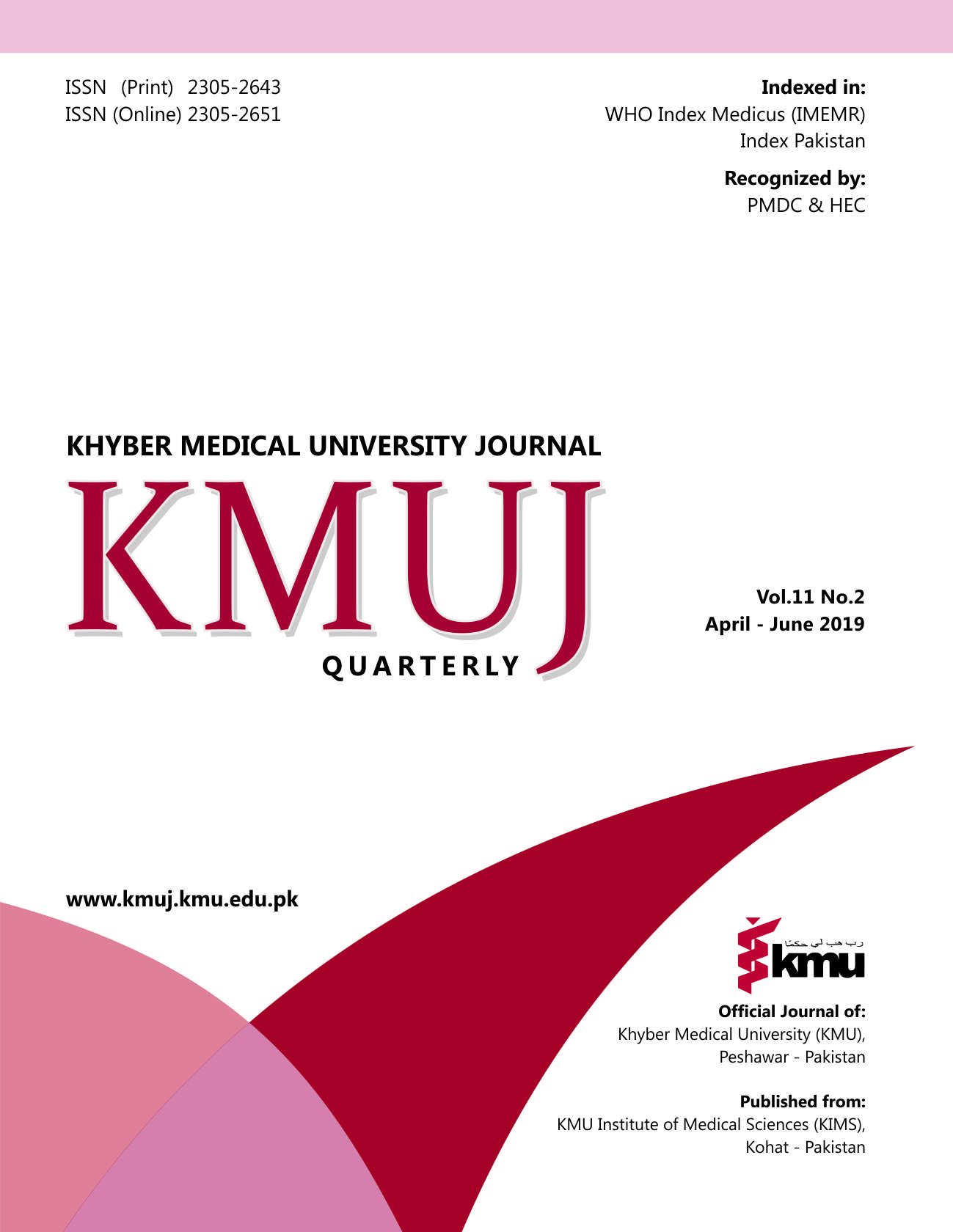ASSOCIATION OF SIT-TO-STAND PATTERN WITH FUNCTIONAL MOBILITY IN STROKE PATIENTS AND ELDERLY POPULATION
Main Article Content
Abstract
OBJECTIVE: To compare sit-to-stand (STS) pattern and different functional mobility tests in stroke and elderly population.
METHODS: This cross-sectional study was carried at Physical therapy departments of Pakistan Railway Hospital Rawalpindi, Rafsan Neuro Rehabilitation Centre Peshawar and DOW Medical Hospital Karachi, Pakistan. Study duration was 6 months from June 2016 to November 2016 with a sample size of 100. Non-Probability purposive sampling technique was adopted for sample collection. After informed consent, data including demographics details and results of applied tests were recorded and analyzed through SPSS version-21. Independent sample T-test was used to measure difference among means, while Odds Ratio was calculated to measure the association.
RESULTS: The mean age of stroke patients was 54.5±9.83 years and mean age of elder population was 65.3±9.44 years. The association of STS pattern and different functional mobility between stroke patients and elderly population showed higher odd for each step of elderly population with an OR of 42.667, 2.667, 1.826, 1.556 and 1.690 for feet behind knees, pre-extension, extension, knee extension and hip extension respectively. The mean scores of Five times sit-to-stand test in stroke population group was 33.8±8.59 sec and 18.4±8.59 sec in elder population (p<0.05). Mean scores of timed up and go test, Tinneti performance oriented mobility scale, Berg Balance scale & Mini-Best test showed a significant difference among these tests (p<0.05).
CONCLUSION: Elderly population can perform STS pattern with much ease as compared to stroke patients while the different functional mobility tests have a significant difference among its values.
Article Details
Work published in KMUJ is licensed under a
Creative Commons Attribution 4.0 License
Authors are permitted and encouraged to post their work online (e.g., in institutional repositories or on their website) prior to and during the submission process, as it can lead to productive exchanges, as well as earlier and greater citation of published work.
(e.g., in institutional repositories or on their website) prior to and during the submission process, as it can lead to productive exchanges, as well as earlier and greater citation of published work.
References
Schmitz TJ, O’Sullivan SB. Examination of coordination and balance. Chap 6. In: O'Sullivan SB, Schmitz TJ, Fulk G. Physical Rehabilitation. 6th Ed. Philadelphia. F.A .Davis. 2013:206.
Mukherjee D, Patil CG. Epidemiology and the global burden of stroke. World Neurosurg 2011;76(6Suppl):S85-90. DOI:10.1016/j.wneu.2011.07.023.
Mozaffarian D, Benjamin EJ, Go AS, Arnett DK, Blaha MJ, Cushman M, et al. Heart disease and stroke statistics-2016 update a report from the American Heart Association. Circulation 2016;133(4):e38-360. DOI: 10.1161/CIR.0000000000000350.
Kamal AK, Rehman H, Mustafa N, Ahmed B, Jan M, Wadivalla F, et al. Diagnostic TCD for intracranial stenosis in acute stroke patients: experience from a tertiary care stroke center in Karachi, Pakistan. BMC Res Notes 2015;8:341.DOI:10.1186/s13104-015-1289-3.
Falcon MI, Riley JD, Jirsa V, McIntosh AR, Shereen AD, Chen EE, et al. The virtual brain: modeling biological correlates of recovery after chronic stroke. Front Neurol 2015;6:228. DOI:10.3389/fneur.2015.00228.
Wasay M, Jabbar A. Fight against chronic diseases (high blood pressure, stroke, diabetes and cancer) in Pakistan; cost-effective interventions. J Pak Med Assoc 2009;59(4):196-7.
Khan M, Kamal AK, Pasha O, Islam M, Azam I, Virk A, et al. Study Protocol: Validation and Adaptation of community-worker-administered stroke symptom questionnaire in a periurban Pakistani community to determine disease burden. J Vasc Interv Neurol 2015;8(1):1-10.
Park JH, Kim YM, Lee NK. The effects of repetitive sit-to-stand training with a paretic-side asymmetrical foot position on the balance of chronic stroke subjects. J Korean Phys Ther 2015;27(3):169-73. DOI:10.18857/jkpt.2015.27.3.169.
Boukadida A, Piotte F, Dehail P, Nadeau S. Determinants of sit-to-stand tasks in individuals with hemiparesis post stroke: a review. Ann Phys Rehabil Med 2015;58(3):167-72. DOI: 10.1016/j.rehab.2015.04.007.
Cho S, Byeon H. Muscle activity of lower extremities for normal adults according to the type of chair and posture during sit-to-stand movement. Int J Biosci Biotech 2015;7(3):51-60. DOI: 10.14257/ijbsbt.2015.7.3.06.
Etnyre B, Thomas DQ. Event standardization of sit-to-stand movements. Phys Ther 2007;87(12):1651-66. DOI: 10.2522/ptj.20060378.
Bohannon RW. Daily sit-to-stands performed by adults: a systematic review. J Phys Ther Sci 2015;27(3):939-42. DOI: 10.1589/jpts.27.939.
Mong Y, Teo TW, Ng SS. 5-repetition sit-to-stand test in subjects with chronic stroke: reliability and validity. Arch Phys Med Rehabil 2010;91(3):407-13. DOI: 10.1016/j.apmr.2009.10.030.
Dowarah BP, Ghosh S. A Comparative Study of Timed Up and Go Test and Tinetti Performance Oriented Mobility Assessment in Predicting Falls in Hemiparetic Stroke Patients. Research & Reviews: J Neurosci 2014;4(3):14-8.
Chinsongkram B, Chaikeeree N, Saengsirisuwan V, Horak FB, Boonsinsukh R. Responsiveness of the Balance Evaluation Systems Test (BESTest) in people with subacute stroke. Phys Ther 2016;96(10):1638-47. DOI:10.2522/ptj.20150621.
Silva PF, Quintino LF, Franco J, Faria CD. Measurement properties and feasibility of clinical tests to assess sit-to-stand/stand-to-sit tasks in subjects with neurological disease: a systematic review. Braz J Phys Ther 2014;18(2):99-110. DOI: 10.1590/S1413-35552012005000155.
Ng SS, Cheung SY, Lai LS, Liu AS, Ieong SH, Fong SS. Association of seat height and arm position on the five times sit-to-stand test times of stroke survivors. Biomed Res Int. 2013;2013: 642362. DOI: 10.1155/2013/642362.
Kwong PW, Ng SS, Chung RC, Ng GY. Foot placement and arm position affect the five times sit-to-stand test time of individuals with chronic stroke. Biomed Res Int 2014; 2014:636530. DOI: 10.1155/2014/636530. Epub 2014 Jun 16.
Goldberg A, Chavis M, Watkins J, Wilson T. The five-times-sit-to-stand test: validity, reliability and detectable change in Elderly females. Aging Clin Exp Res 2012;24(4):339-44. DOI: 10.1007/BF03325265.
Azad A, Mehraban AH, Mehrpour M, Mohammadi B. Clinical assessment of fear of falling after stroke: validity, reliability and responsiveness of the Persian version of the Fall Efficacy Scale-International. Med J Islam Repub Iran 2014 18;28:131.
Downs S, Marquez J, Chiarelli P. Normative scores on the Berg Balance Scale decline after age 70 years in healthy community-dwelling people: a systematic review. J Physiother 2014;60(2):85-9. DOI: 10.1016/j.jphys.2014.01.002. Epub 2014 Jun 13.
Soma Y, Tsunoda K, Kitano N, Jindo T, Tsuji T, Saghazadeh M, et al. Relationship between built environment attributes and physical function in Japanese community‐dwelling Elderly adults. Geriatr Gerontol Int 2017;17(3):382-90. DOI: 10.1111/ggi.12717.
